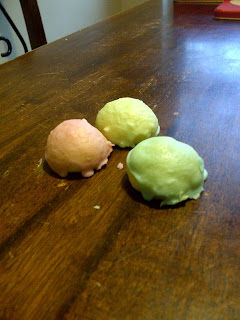A Formal Introduction to Kuwait
I have been in Kuwait for one week now! Yes…Only one
week, hahaha! I haven’t blogged for a few days because it’s been pretty busy. However,
before I get into all that, I really want to tell you about Kuwait.
Now, I am by no means an expert, so I will
absolutely let you know where I got the following information.
Firstly, Kuwait is in the Middle East and is not spelled with a ‘Q’; it is pronounced
“koo-ate,” not “cue-wait”. I have yet to visit Kuwait City, the capital of Kuwait. I have included a map so you can see where Kuwait is
situated in the Middle East in relation to other countries (at the bottom of the post). Kuwait shares
borders with Iraq, Saudi Arabia and the water of the Persian Gulf. Kuwait is
located in the eastern part of the Middle East and is north of Qatar (where the
Epps are). Kuwait boasts a large population (3,632,009 people) for a country that’s
roughly the size of the state of New Jersey.
Although Kuwaitis make up over 30% of the population
here, other Arabs (from Yemen, Saudi Arabia, Egypt, Iran, etc…)
account for almost 30% of the population. The other 40% consists of Southeast
Asians (just over 35%), as well as “other” ethnicities (who make up the last 5%, roughly, of the population).
Both Arabic and English are spoken in Kuwait,
although Arabic is the official language (and as you know, I need to learn
Arabic). Kuwait’s literacy rate, 93.3%, is extremely high compared to other
countries in the Middle East, and is "the result of extensive government support for the education system." Government support for improving the education system for Kuwaitis is the main reason I'm able to teach here. Most students enter on goverment-funded scholarships.
Kuwait’s natural resources are, as I’m sure most
people are aware, oil, natural gas and fish. I have also been told that in
Kuwait, pearl diving is popular and that gold is readily available at extremely
reasonable prices. However, I have yet to look into pearl diving and purchasing
gold. That being said, Kuwaiti dinar (KWD) are expensive. On a good day, 1kd
(Kuwaiti dinar), is $3.44 (CAD). The most I've paid is $3.67...YIKES! This conversion rate is the reason I have heart palpitations
when I mentally convert the cost of items here.
Despite westerners’ skewed perception of the Middle
East, Kuwait is a very safe country, especially when you compare it to other
countries in the ME. However, women should always ignore men when they are
giving them any attention (because they DO do this…A LOT), and as a foreigner/expat/visitor, just don’t argue
with Arab locals. Other than that, the country can be proud of the safe and friendly
environment (with the exception of driving, which I've mentioned before). Like any other
unknown land, figure out where, as a tourist/traveller, you need to be careful (thieves, unsafe areas, where your embassy is, etc...), and just be aware of your surroundings. Even being a foreign woman here, I feel
very comfortable, but that doesn’t mean I’m going to wander around at night,
alone, in unlit areas. You just have to use your common sense and it’s all good!
You should visit me in Kuwait. Although, there is a
problem with processing tourist visas here right now because of an influx of
people who want to enter the country (surprised?). Canadians, if I’ve been
correctly informed, do not have to worry about this because we simply get our
3-month travel visas from the visa counter (in the Kuwait airport), after
purchasing the visa stamp for your paperwork (3KD). Easy-peasy.
Sooo, what the heck can you do in Kuwait for fun? Well
that’s a blog for another day, but that post will be up soon!
Welcome to Kuwait. We hope you enjoy your stay :)
Map of the Middle East


Comments
Post a Comment